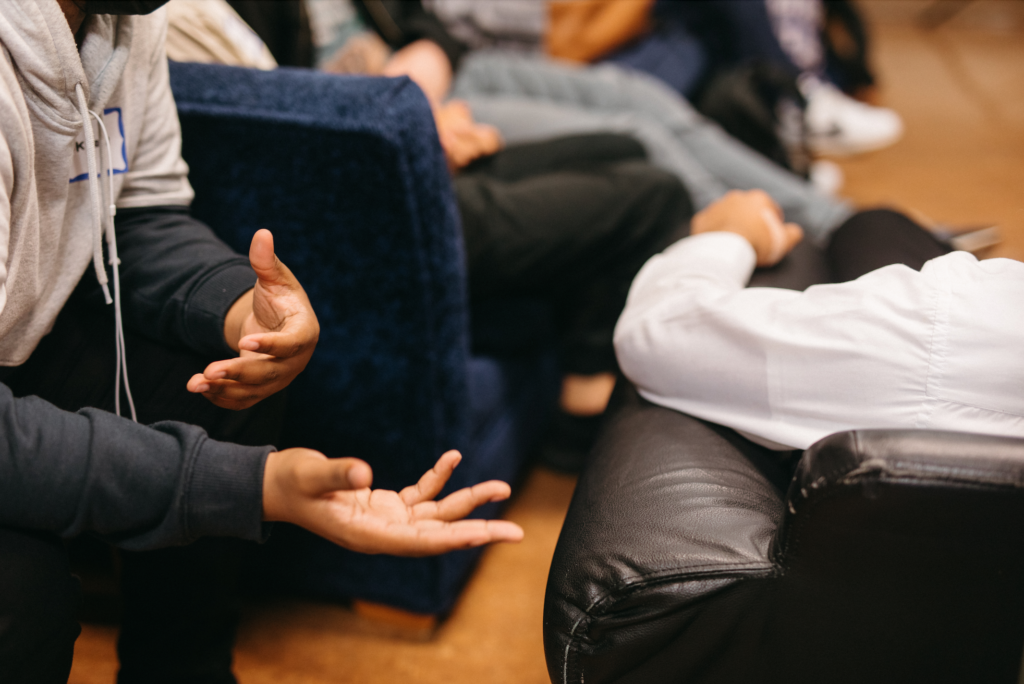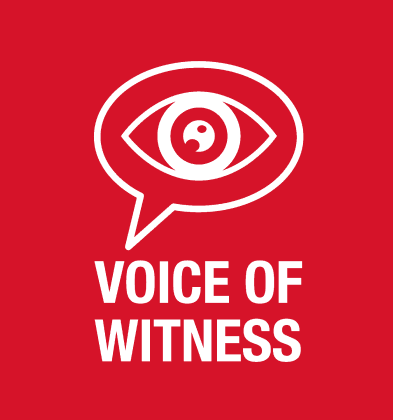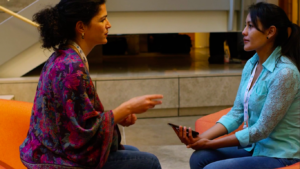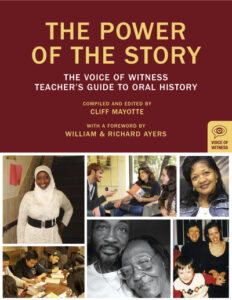
What does “trauma-informed” mean or look like in action? This Voice of Witness (VOW) resource explores and outlines 10 key trauma-informed practices for storytelling work. While our approach is focused on oral history, these principles apply to many types of community-based, interview-based, or relational work. Whether you’re a journalist, teacher, lawyer, social worker, organizer, healthcare professional, or artist, these concepts can help guide your interactions.
Brief Definition:
Sharing one’s story with someone fully committed to deep listening can be a beneficial and reparative experience. However, recounting traumatizing experiences can also be painful and carries the risk of retraumatization.
“Trauma” refers to a distressing or disturbing experience or event that results in lasting emotional, psychological, or physical effects. Trauma can impact how a person remembers and what they remember, can lead to feelings of helplessness or overwhelm, and can have immediate symptoms or longer-term impacts.
“Trauma-informed” refers to an approach or framework that acknowledges the wide-ranging impacts of trauma and understands potential paths for healing. It emphasizes the need to recognize the signs and symptoms of trauma, and it actively seeks to avoid re-traumatization or further harm by fostering a safe and supportive environment. Trauma-informed practices are rooted in an understanding that trauma affects people in diverse and profound ways. This framework reflects a commitment to integrate awareness and responsiveness into policies and procedures.
Key Practices:
1. Creating a Safe Environment
Before the project begins, have conversations with narrators* around safety (physical, legal, and emotional/psychological) and assess any potential risks or harm. Evaluate protection needs together and create plans. If needed, decide on any narrator anonymity, pseudonym safeguards, or changing identifying details to protect privacy.
Establish a safe, comfortable space for interviews and storytelling sessions. This involves being mindful of the setting, tone, and pacing of the conversation to help participants feel secure and protected from further harm.
2. Informed Consent, Agency, and Transparency
Always ensure that participants fully understand the scope and purpose, process, and potential outcomes of sharing their stories. Support them to set boundaries on what they wish to share and give them control over the narrative, including the option to opt out, retract, or modify their contributions at any time during or after the project. Respect their boundaries and do not push for more information. Provide multiple opportunities to affirm ongoing consent and share drafts for edits and approval. The narrator should always have ownership over their own story.
3. Providing Choice
Actively provide choices and options to narrators, such as selecting the location of interviews or specific interviewers, whenever possible. This approach ensures people retain a sense of agency and control.
4. Non-Judgmental Listening
Practice active and empathetic listening without judgment or interruption. Validate the narrator’s experiences and emotions through appropriate eye contact and body language, ensuring they feel heard and respected throughout the process. Remember, they are the experts of their own lived experience.
5. Sensitivity to Triggers and Re-traumatization
Do research and be aware of language, questions, or subjects that might trigger distress or re-traumatization. Approach sensitive topics with care, and offer breaks or the opportunity to pause, stop, or redirect the conversation at any time. Offer to show the narrator a list of potential questions ahead of the interview.
6. Support Resources
Come equipped with referrals to support resources or systems, such as counseling or community services. Make sure narrators know where to find help if they need it. Peer support can also be valuable; you can ask if they have a friend or family member they can speak or be with after the interview to debrief. Check in to confirm they have a plan, even if it might just be going for a short walk or eating some food.
7. Trust, Collaboration, and Reliability
Build trust through clear communication, consistency, and transparency in decision-making. This helps to establish a reliable relationship. Prioritize partnership and co-creation at every stage. Moving “at the speed of trust” is vital in order to avoid an extractive or transactional approach. Stay in touch with narrators after the oral history process, developing the relationships further and connecting them to organizations, movements, and more opportunities to share their stories if they are interested.
8. Cultural Humility and Contextual Awareness
Recognize and respect the cultural, social, and historical contexts that shape participants’ experiences and perspectives. This includes being aware of power dynamics, systemic injustices, and the impact of collective or intergenerational trauma. Practice cultural humility, a process of self-reflection that involves reflecting on biases and assumptions; being open to learning from others; and honoring their beliefs, customs, and values.
9. Complexity, Strength, and Wholeness
Focus on the strengths and complexity of individuals rather than solely on their trauma. Let narrators take the lead in where the conversation goes, creating space for nuance and showcasing joy, wonder, and humor in addition to any potential trauma or hardship. Begin and end the interview with more comfortable, casual conversation and questions like “how are you today?” or “what are you looking forward to”?
10. Ethical Storytelling
Prioritize the dignity and integrity of narrators by avoiding sensationalism or exploitation of their stories. Support people’s ability to shape and tell their stories in a way that best reflects their truth. For more info on a framework grounded in respect and equity, read VOW’s Ethical Storytelling Principles.
Additional Resources:
VOW offers ethics-driven storytelling and program support to organizations, advocates, artists, educators, and more. These collaborations harness the power of oral history to promote empathy, learning, community-building, and action. We partner to develop customized, interactive trainings, projects, and activities, using our methodology to advance your mission. Reach out to inquire!
Use the following resources to learn more:
- The Benefits of Oral History: A Primer
- VOW’s Ethical Storytelling Principles
- Say It Forward: A Guide to Social Justice Storytelling
- Buffalo Center for Social Research Trauma-Informed Care Resource
- Nervous: Essays on Heritage and Healing by Jen Soriano
- Truth and Repair: How Trauma Survivors Envision Justice by Judith Lewis Herman
- Help for the Helper: Self-Care Strategies for Managing Burnout and Stress by Babette Rothschild
- The Body Keeps the Score: Brain, Mind, and Body in the Healing of Trauma by Bessel Van Der Kolk
*As oral history practitioners, we use the term “narrator” rather than “interviewee” or “interview subject” to refer to the person sharing their story, as people are narrating their own experiences with agency rather than simply providing answers to questions. Some organizations might use the term “storyteller” instead.



